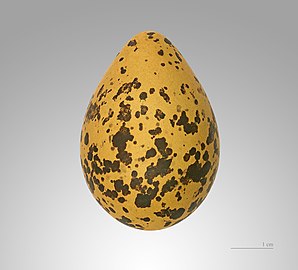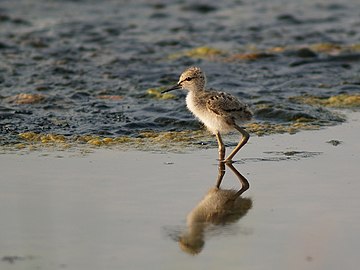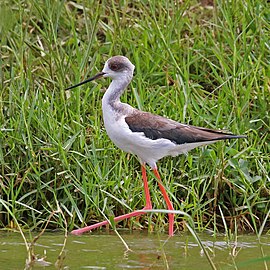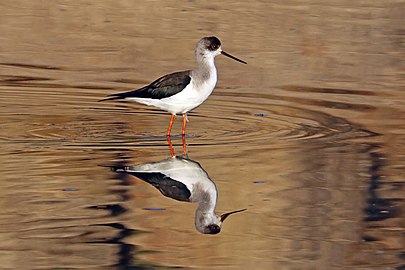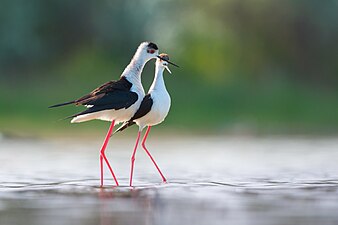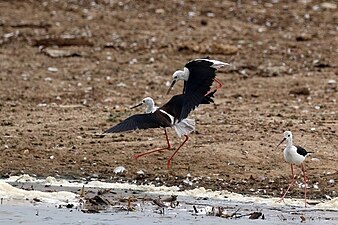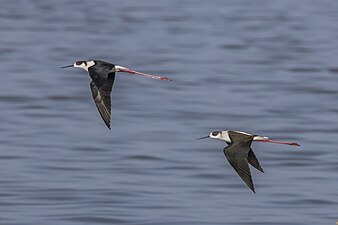Black-winged stilt
| Black-winged stilt | |
|---|---|
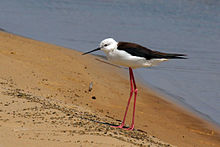
| |

| |
| Black-winged stilt in Marievale Nature Reserve | |
| Scientific classification | |
| Domain: | Eukaryota |
| Kingdom: | Animalia |
| Phylum: | Chordata |
| Class: | Aves |
| Order: | Charadriiformes |
| Family: | Recurvirostridae |
| Genus: | Himantopus |
| Species: | H. himantopus
|
| Binomial name | |
| Himantopus himantopus | |

| |
| Range of H. himantopus (sensu lato, see text)
Breeding Resident Passage Non-breeding
| |
| Synonyms | |
| |
The black-winged stilt (Himantopus himantopus) is a widely distributed, very long-legged wader in the avocet and stilt family Recurvirostridae. Its scientific name, Himantopus himantopus, is sometimes used to generalize a single, almost cosmopolitan species. Alternatively, it is restricted to the form that is widespread in Europe, Asia and Africa, which equals the nominate group of H. himantopus sensu lato. Meanwhile, the black-necked (H. mexicanus) and white-backed stilts (H. melanurus) both inhabit the Americas; the pied stilt (H. leucocephalus) ranges from Australasia and New Zealand. Today, most sources accept between one and four actual species.[1][2][3][4]
Taxonomy
[edit]The black-winged stilt was formally described in 1758 by the Swedish naturalist Carl Linnaeus in the tenth edition of his Systema Naturae. He placed it with the plovers in the genus Charadrius and coined the binomial name Charadrius himantopus. He specified the type locality as southern Europe.[5][6] The taxonomic name Himantopus comes from Greek, meaning "strap-foot" or "thong-foot".[7] The black-winged stilt is now one of five species placed in the genus Himantopus that was introduced by the French naturalist Mathurin Jacques Brisson in 1760. The species is monotypic: no subspecies are recognised.[8]
The taxonomy of this bird is still somewhat contentious; it is one of four distinct species, which sometimes are considered subspecies of H. himantopus. H. himantopus sensu lato is made up of a single species, with 5–7 subspecies, and is sometimes referred to as the common stilt. The name "black-winged stilt" refers to H. himantopus sensu stricto, with two subspecies (H.h. himantopus from the Palearctic to South Asia, and H.h. meridionalis from the Afrotropical region).[9]
Description
[edit]Adults are 33–36 cm (13–14 in) long, with long, pink legs, and a long, rather thin black bill. The birds are generally black above and white below, with a white head and neck (with a varying amount of black, species-dependent). Males have a black back, often with a greenish gloss or sheen. Females' backs have a brownish hue, contrasting with the black remiges. In populations where the top of the head is normally white (at least in winter), females tend to have less black on the head and neck the entire year-round, while males often have much more black, particularly in summer. This difference is not clear-cut, however, and males usually grow all-white head feathers in winter.[citation needed]
Immature birds are grey, instead of black, and have a markedly sandy hue on their wings, with light feather fringes appearing as a whitish line in flight.
-
Egg
MHNT -
Nestling
Ecology and status
[edit]The breeding habitat of all these stilts is marshes, shallow lakes and ponds. Some populations are migratory and move to the ocean coasts in winter; those in warmer regions are generally resident or short-range vagrants. In Europe, the black-winged stilt is a regular spring overshoot vagrant north of its normal range, occasionally remaining to breed in northern European countries. Pairs successfully bred in Britain in 1987,[10] and after a 27-year hiatus there were two instances of successful breeding in Southern England in 2014.[11] 13 young were fledged in southern England in 2017.[12] Four chicks were successfully fledged in northern England in 2022; this is believed to be the most northerly breeding success for the black-winged stilt.[13][14]
These birds pick up their food from sand or water. They eat mainly insects and crustaceans.
The nest site is a bare spot on the ground near water. These birds often nest in small groups, sometimes with avocets.
The black-winged stilt is one of the species to which the Agreement on the Conservation of African-Eurasian Migratory Waterbirds applies.
References
[edit]- ^ a b BirdLife International (2019) [amended version of 2016 assessment]. "Himantopus himantopus". IUCN Red List of Threatened Species. 2019: e.T22727969A155440465. doi:10.2305/IUCN.UK.2019-3.RLTS.T22727969A155440465.en. Retrieved 13 November 2021.
- ^ "Species factsheet: Black-necked Stilt". BirdLife International (BLI). 2008. Retrieved 24 September 2008.[dead link]
- ^ "Species factsheet: Black-winged Stilt". BirdLife International (BLI). 2023. Retrieved 9 December 2023.
- ^ "Species factsheet: White-headed Stilt". BirdLife International (BLI). 2008. Retrieved 24 September 2008.[dead link]
- ^ Linnaeus, Carl (1758). Systema Naturae per regna tria naturae, secundum classes, ordines, genera, species, cum characteribus, differentiis, synonymis, locis (in Latin). Vol. 1 (10th ed.). Holmiae (Stockholm): Laurentii Salvii. p. 151.
- ^ Peters, James Lee, ed. (1934). Check-List of Birds of the World. Vol. 2. Cambridge, Massachusetts: Harvard University Press. p. 289.
- ^ Jobling, James (2010). Helm Dictionary of Scientific Bird Names. London: Helm. p. 191.
- ^ Gill, Frank; Donsker, David; Rasmussen, Pamela, eds. (December 2023). "Buttonquail, thick-knees, sheathbills, plovers, oystercatchers, stilts, painted-snipes, jacanas, Plains-wanderer, seedsnipes". IOC World Bird List Version 14.1. International Ornithologists' Union. Retrieved 9 February 2024.
- ^ "Black-winged Stilt Himantopus himantopus (Linnaeus, 1758)". Avibase. Denis Lepage. Retrieved 19 August 2017.
- ^ Boyd, Bill (1987). "The Black-winged Stilts at Holme Norfolk Naturalists' Trust reserve". Twitching. 1 (6): 148–150.
- ^ RSPB. "27-year first as rare black-winged stilt chicks hatch at RSPB reserves in southern England". RSPB Website. Retrieved 16 November 2015.
- ^ "UK's rare black-winged stilt numbers soar". Countryfile Magazine. BBC. Retrieved 20 August 2017.
- ^ "Potteric Carr: Black-winged stilt chicks in northern first". BBC News. 17 June 2022. Retrieved 11 August 2022.
- ^ "Review of the Week: 13-19 June 2022". www.birdguides.com. 20 June 2022. Retrieved 11 August 2022.
Further reading
[edit]- Hayman, Peter; Marchant, John; Prater, Tony (1986). Shorebirds: an identification guide to the waders of the world. Boston: Houghton Mifflin. ISBN 0-395-60237-8.
External links
[edit]- "Black-winged stilt media". Internet Bird Collection.
- Black-winged Stilt species text in The Atlas of Southern African Birds.
- Ageing and sexing (PDF; 2.7 MB) by Javier Blasco-Zumeta & Gerd-Michael Heinze
- "Himantopus himantopus". Avibase.
- Black-winged stilt photo gallery at VIREO (Drexel University)
- Interactive range map of Himantopus himantopus at IUCN Red List
- Audio recordings of Black-winged stilt on Xeno-canto.



